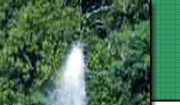Frequently Asked Questions
My pond is murky and smelly, with a lot of weeds at the bottom.
How do I clean it up?
Silver Creek advocates a three pronged approach to cleaning
up ponds. The keys are aeration, dealing with nutrients and blocking
sunlight. The more oxygen in the water the clearer it
will be, that is where aeration comes into play. Oxygen helps
to breakdown
the nutrients, nitrogen and phosphorous into forms that are unavailable
for plants to use. The nutrients can also be reduced by
adding beneficial bacteria to the pond. The bacteria compete
with the
weeds in the pond for nitrogen and phosphorous. The bacteria
also become food source for small organisms in the water, that
in turn are eaten by bigger organisms and so on up the food chain.
Nothing is eating the plants but the bacteria are a beneficial
food source. Blocking sunlight is achieved through using a product
such as TrueBlue. TrueBlue is a natural blue dye that is not
harmful to living organisms. The blue colour simply blocks
the blue-green wavelength of sunlight entering the water. This
is the wavelength plants need in order to perform photosynthesis.
For
a further explanation on Silver Creek's approach to pond rehabilitation
see the articles on this web site.
Why put trout in my pond at all?
Trout are a wonderful addition to a pond for a variety of reasons,
not least of which is the sight of seeing a fish jump out of
the water to catch an insect. The backyard pond is often also
the first and sometimes only chance a child gets to experience
the joy of fishing. The squeals of delight when a child catches
a fish is a sound that most people are familiar with. The more
practical reasons for stocking a pond include concerns about
mosquitoes and leeches. Trout are great predators and eat a tremendous
amount of insects including mosquito larvae. If the pond is
used for swimming at all trout are also great at keeping leeches
at bay.
Can different species of trout live in the same pond?
Yes, certainly, we have rainbows, browns and speckles all living
in the same ponds here.
My pond is twelve feet deep. What kind of trout can live in
it?
A pond of that depth would support rainbow and brown trout.
Rainbow trout prefer water temperatures of 10 to 20°C while
browns thrive in 15 to 25°C. This pond could be too warm
for speckled trout, however, they like it nice and cold at 5
to 15°C.
My pond doesn't have any water flowing into it. Can I put trout
in it?
Certainly, if the pond is at least 10 feet deep. Unless the
summer months are extremely hot (over 30°C for several days
and no rain) rainbows and brown trout would be able to survive
in such a situation. You would be advised to put some form of
aeration in that pond to keep oxygen levels up which will help
the trout survive over the summer (see aeration page) or fish
the trout out over the summer. The ice
cover may
get
too
thick
in
the winter
for the fish to survive if no aerator is used.
I've decided I need an aerator in my pond. What type should
I be looking at?
For ponds that have no access to electricity, a windmill aerator
is the best option. For ponds that are 1/4 or so acres,
a Little Titan or Starburst aerator is ideal. For .5 acre to
.75 acre
ponds the AquaGems are very good. For larger, 1 acre plus ponds
please contact us. See the aerator page for further details.
Should I thin out the cattails and bulrushes around my pond?
Cattails and bulrushes are a great addition to a pond. They
act as a kind of kidney for the pond, filtering out the nutrients
that are detrimental to water quality. However, too much of anything
is not good. Cattails in particular are invasive and if not periodically
cut back can take over a pond.
What other plants can I have around my pond?
Shoreline plants such as irises, arrowroot and cardinal flowers
are a useful and beneficial addition to a pond. Plants at the
shore can intercept nutrients that may enter the pond by surface
run-off. See the plant page for further details.




